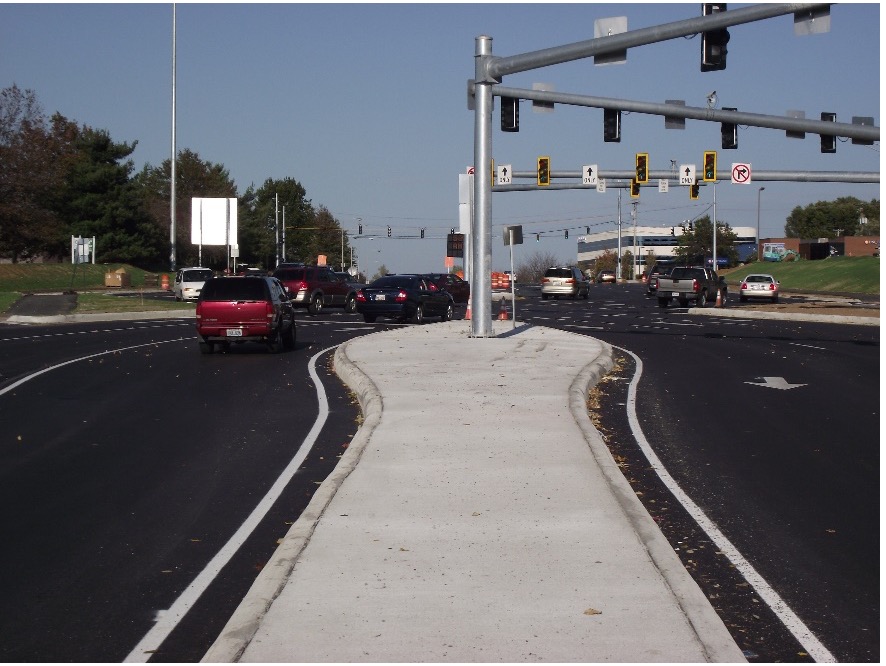Search for articles or browse our knowledge portal by topic.
Clear Zone for Traffic Appurtenances, Utilities, and Permitted Activities
While an unobstructed roadside is preferred, there is a need to accomodate roadside appurtenances, utilities, and activities initiated through the permitting process.
Some appurtenances need to be placed near the traveled way. Man-made fixed objects that frequently occupy highway rights of way include highway signs, roadway lighting, traffic signals, and utility poles.
2.1 Traffic Appurtenances
KYTC’s Traffic Operations Guidance Manual makes the following recommendations about traffic appurtenances in clear zones:
- Signs within the clear zone should be on breakaway supports.
- Locate traffic signal and beacon supports and equipment outside the clear zone. Pedestrian poles on breakaway bases are an exception.
- Use a barrier to shield high mast poles within the clear zone.
Conventional lighting poles may be located in the clear zone if they are on breakaway supports and equipped with electrical disconnects. Non-breakaway supports may be used in low-speed (≤ 35 mph) urban environments that have significant pedestrian activity, if supported by an engineering study

2.2 Utility Accommodations
Obstacles created by utility accommodation that impact the available clear zone include facilities such as poles, hydrants, regulators, junctions, cabinets, stations, and other structures. KYTC’s Utility and Rails Manual states that utilities should be relocated outside the clear zone, be safely traversed, or use breakaway supports. If these conditions are not met, exceptions are sometimes made if the facility is shielded by guardrail or other protection designed to ensure motorist safety. These exceptions shall be explicitly requested within the body of the no charge authorization package, as detailed in UR-1000. For permit requirements involving utilities, see Section 3 of this document and PE-301 and PE- 302 in KYTC’s Permits Manual.
KYTC’s Permits Guidance Manual addresses requirements for permitted activities within the clear zone.
3.1 Work Zones for Permitted Activities
Construction materials and equipment must not be placed inside the clear zone during periods of non-work.
3.2 Utilities
The Permits Manual also prescribes policies and conditions for accommodating utility facilities within the right-of-way limits of roadways on the Kentucky State Highway System. When new pole lines are installed longitudinally, they shall be located outside the clear zone. On facilities with full access control, support structures for overhead utility lines, if allowed on right of way, shall be outside the clear zone. Open trenching of underground utility facilities on roadways with full access control is not allowed in the clear zone unless approved by the State Highway Engineer (SHE) and — if applicable — the FHWA.
3.3 Signs and Other Roadside Appurtenances
Welcome signs and associated landscaping requested through the permit process shall be located outside the clear zone. Signs advertising fairs, parades, and festivals must use a breakaway design or be located outside the clear zone.
When garbage containers are permitted on the right of way, they shall be located outside the minimum required clear zone as designated in the RDG. Individuals or other entities inside the clear zone and within the right of way of state-maintained routes may place temporary garbage containers in the clear zone if permitted by a district.
Plantings and other landscaping elements shall not pose a hazard within the clear zone. Use Table 2.1 from the Federal Highway Administration’s Barrier Guide for Low Volume and Low Speed Roads for landscaping requests made through the permit process. Values in the table can be used to determine an alternative clear zone distance for state routes within urban areas in curb and gutter sections with a speed limit £ 35 MPH.
- HD-800 Roadside Design
- HD-206.5 Roadside Design in Work Zones
- HD 1201.4 Sign Supports
- 03.03 Equipment and Traffic Control Devices Not In Use.
KYTC Construction (CST) Manual
- CST 1315 Inspecting Sign Installation
- CST 1317 Signalization
KYTC Traffic Operations (TO) Manual
- TO-609-1 Operational Design – Physical Design (Hardware)
- TO-705 Lighting – Plan Development
- TO-710 Lighting – Intersection Delineation Lighting
KYTC Utilities and Rails (UR) Manual
- UR-401-2 General Utility Accommodations Practices – Design Considerations
- UR-401-4 General Utility Accommodation Practices – Overhead Facility Design
- UR-402-3 Utility Installations on Fully Controlled Access Highways – Overhead Utility Crossings
- PE-204 General – Work Zone Safety
- PE-301 Utilities – Overview
- PE 302 Utilities – Installations on Fully Controlled Access Highways
- PE 1101 Welcome Signs – Overview
- PE-1201 Fairs, Parades, Festivals, & Banners – Overview
- PE-1301 Garbage Containers – Overview
- PE-2001 Landscaping – Overview
AASHTO. Roadside Design Guide, Fourth Edition, RSDG-4. American Association of State Highway and Transportation Officials, Washington, DC, 2011.
AASHTO. Guidelines for Geometric Design of Low-Volume Local Roads, Second Edition. American Association of State Highway and Transportation Officials, Washington, DC, 2019.
FHWA. Barrier Guide for Low Volume and Low Speed Roads. FHWA-CFL/TD-05-009. FHWA- Central Federal Lands Highway Divisions, Lakewood, CO, November 2005.
Roadside Safety Clear Zone Concepts Knowledge Book:
Access the complete Knowledge Book here: Roadside Safety Knowledge Book and Clear Zone Concepts Knowledge Book
Previous Article: Clear Zone in Work Zones

